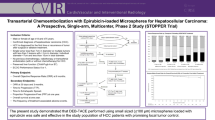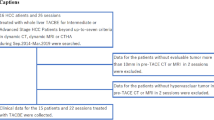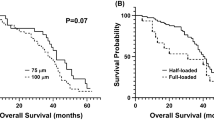Abstract
Purpose
There is no consensus on switching anticancer agents loaded onto drug carriers in transcatheter arterial chemoembolization (TACE) for hepatocellular carcinoma (HCC). This study aimed to evaluate the safety and clinical outcomes of TACE with cisplatin-loaded microspheres (CLM-TACE) in HCC patients refractory to TACE with epirubicin-loaded microspheres (ELM-TACE).
Methods
Between February 2008 and June 2010, 85 patients with unresectable HCC refractory to ELM-TACE were enrolled to undergo CLM-TACE. The number of ELM-TACE sessions until judgment of resistance ranged from 1 to 4 (median, 2.1). CLM-TACE was performed using 50–100-μm superabsorbent polymer microspheres loaded with 1 mg cisplatin/1 mg microspheres together with hepatic arterial infusion of 25 mg cisplatin and 500 mg 5-fluorouracil per patient. Tumor responses were evaluated by computed tomography according to the European Association for the Study of the Liver criteria.
Results
The median number of CLM-TACE treatment sessions was 1.8 (range, 1–5), and the mean total dose of cisplatin per session was 42.8 mg (range, 30.0–59.0). After 6 months, 3 (3.5%) patients achieved complete response, 31 (36.5%) had partial response, 15 (17.6%) had stable disease, and 36 (42.4%) had progressive disease. The median overall survival and time to treatment failure after initial CLM-TACE were 13.3 and 7.2 months, respectively. Overall, 9.4% of patients experienced grade 3/4 adverse events.
Conclusion
Switching the loaded agent from epirubicin to cisplatin is a safe, well-tolerated, and efficacious treatment strategy for salvage TACE with drug-eluting microspheres in HCC patients refractory to ELM-TACE.
Similar content being viewed by others
References
El-Serag HB, Rudolph KL (2007) Hepatocellular carcinoma: epidemiology and molecular carcinogenesis. Gastroenterology 132:2557–2576
Cottone M, Turri M, Caltagirone M et al (1988) Early detection of hepatocellular carcinoma associated with cirrhosis by ultrasound and alfafetoprotein: a prospective study. Hepatogastroenterology 35:101–103
Bruix J, Sherman M, Llovet JM et al (2001) Clinical management of hepatocellular carcinoma. Conclusions of the Barcelona-2000 EASL conference. European Association for the Study of the Liver. J Hepatol 35:421–430
Llovet JM, Bruix J (2003) Systematic review of randomized trials for unresectable hepatocellular carcinoma: chemoembolization improves survival. Hepatology 37:429–442
Llovet JM, Real MI, Montana X et al (2002) Arterial embolization or chemoembolization versus systemic treatment in patients with unresectable hepatocellular carcinoma: a randomized controlled trial. Lancet 359:1734–1739
Marelli L, Stigliano R, Triantos C et al (2007) Transarterial therapy for hepatocellular carcinoma: which technique is more effective? A systematic review of cohort and randomized studies. Cardiovasc Intervent Radiol 30:6–25
Yamada R, Sato M, Kawabata M et al (1983) Hepatic artery embolization in 120 patients with unresectable hepatoma. Radiology 148:397–401
Brown DB, Cardella JF, Sacks D et al (2009) Quality improvement guidelines for transhepatic arterial chemoembolization, embolization, and chemotherapeutic infusion for hepatic malignancy. J Vasc Interv Radiol 20(Suppl 7):S219–S226
Satake M, Uchida H, Arai Y et al (2008) Transcatheter arterial chemoembolization (TACE) with lipiodol to treat hepatocellular carcinoma: survey results from the TACE study group of Japan. Cardiovasc Intervent Radiol 31:756–761
Sonomura T, Yamada R, Kishi K et al (1997) Dependency of tissue necrosis on gelatin sponge particle size after canine hepatic artery embolization. Cardiovasc Intervent Radiol 20:50–53
Varela M, Real MI, Burrel M et al (2007) Chemoembolization of hepatocellular carcinoma with drug eluting beads: efficacy and doxorubicin pharmacokinetics. J Hepatol 46:474–481
Hong K, Khwaja A, Liapi E et al (2006) New intra-arterial drug delivery system for the treatment of liver cancer: preclinical assessment in a rabbit model of liver cancer. Clin Cancer Res 12:2563–2567
Lewis AL, Gonzalez MV, Lloyd AW et al (2006) DC Bead: in vitro characterization of a drug-delivery device for transarterial chemoembolization. J Vasc Interv Radiol 17:335–342
Jordan O, Denys A, De Baere T et al (2010) Comparative study of chemoembolization loadable beads: in vitro drug release and physical properties of DC bead and hepasphere loaded with doxorubicin and irinotecan. J Vasc Interv Radiol 21:1084–1090
Maeda N, Osuga K, Higashihara H et al (2010) In vitro characterization of cisplatin-loaded superabsorbent polymer microspheres designed for chemoembolization. J Vasc Interv Radiol 21:877–881
Grosso M, Vignali C, Quaretti P et al (2008) Transarterial chemoembolization for hepatocellular carcinoma with drug-eluting microspheres: preliminary results from an Italian multicenter study. Cardiovasc Intervent Radiol 31:1141–1149
Seki A, Hori S, Kobayashi K et al (2010) Transcatheter arterial chemoembolization with epirubicin-loaded superabsorbent polymer microspheres for 135 hepatocellular carcinoma patients: single-center experience. Cardiovasc Intervent Radiol. doi:10.1007/s00270-010-9975-y
Poggi G, Amatu A, Montagna B et al (2009) OEM-TACE: a new therapeutic approach in unresectable intrahepatic cholangiocarcinoma. Cardiovasc Intervent Radiol 32:1187–1192
Osuga K, Hori S, Hiraishi K et al (2008) Bland embolization of hepatocellular carcinoma using superabsorbent polymer microspheres. Cardiovasc Intervent Radiol 31:1108–1116
Yoshikawa M, Ono N, Yodono H et al (2008) Phase II study of hepatic arterial infusion of a fine-powder formulation of cisplatin for advanced hepatocellular carcinoma. Hepatol Res 38:474–483
Maeda N, Osuga K, Mikami K et al (2008) Angiographic evaluation of hepatic arterial damage after transarterial chemoembolization for hepatocellular carcinoma. Radiat Med 26:206–212
Lacouture ME, Maitland ML, Segaert S et al (2010) A proposed EGFR inhibitor dermatologic adverse event-specific grading scale from the MASCC skin toxicity study group. Support Care Cancer 18:509–522
Kalayci C, Johnson PJ, Raby N et al (1990) Intraarterial adriamycin and lipiodol for inoperable hepatocellular carcinoma: a comparison with intravenous adriamycin. J Hepatol 11:349–353
Arora AS, de Groen PC, Croall DE et al (1996) Hepatocellular carcinoma cells resist necrosis during anoxia by preventing phospholipase-mediated calpain activation. J Cell Physiol 167:434–442
Chang JM, Tzeng WS, Pan HB et al (1994) Transcatheter arterial embolization with or without cisplatin treatment of hepatocellular carcinoma. A randomized controlled study. Cancer 74:2449–2453
Kawai S, Okamura J, Ogawa M et al (1992) Prospective and randomized clinical trial for the treatment of hepatocellular carcinoma: a comparison of lipiodol-transcatheter arterial embolization with and without Adriamycin (first cooperative study). The Cooperative Study Group for Liver Cancer Treatment of Japan. Cancer Chemother Pharmacol 31(suppl):S1–S6
Sahara S, Kawai N, Sato M et al (2010) Prospective comparison of transcatheter arterial chemoembolization with Lipiodol–epirubicin and Lipiodol–cisplatin for treatment of recurrent hepatocellular carcinoma. Jpn J Radiol 28:362–368
Kawai S, Tani M, Okamura J et al (1997) Prospective and randomized trial of lipiodol-transcatheter arterial chemoembolization for treatment of hepatocellular carcinoma: a comparison of epirubicin and doxorubicin (second cooperative study). The Cooperative Study Group for Liver Cancer Treatment of Japan. Semin Oncol 24(2 suppl 6):S6-38–S6-45
Nicolini A, Martinetti L, Crespi S et al (2010) Transarterial chemoembolization with epirubicin-eluting beads versus transarterial embolization before liver transplantation for hepatocellular carcinoma. J Vasc Interv Radiol 21:327–332
Shen DW, Akiyama S, Schoenlein P et al (1995) Characterisation of high-level cisplatin-resistant cell lines established from a human hepatoma cell line and human KB adenocarcinoma cells: cross-resistance and protein changes. Br J Cancer 71:676–683
Moriguchi M, Takayama T, Nakamura M et al (2010) Phase I/II study of a fine-powder formulation of cisplatin for transcatheter arterial chemoembolization in hepatocellular carcinoma. Hepatol Res 40:369–375
Kawaoka T, Aikata H, Takaki S et al (2009) Transarterial infusion chemotherapy using cisplatin-lipiodol suspension with or without embolization for unresectable hepatocellular carcinoma. Cardiovasc Intervent Radiol 32:687–694
Lammer J, Malagari K, Vogl T et al (2010) Prospective randomized study of doxorubicin-eluting-bead embolization in the treatment of hepatocellular carcinoma: results of the PRECISION V study. Cardiovasc Intervent Radiol 33:41–52
Kawamura Y, Ikeda K, Hirakawa M et al (2009) Efficacy of platinum analogue for advanced hepatocellular carcinoma unresponsive to transcatheter arterial chemoembolization with epirubicin. Hepatol Res 39:346–354
Conflict of interest
The authors declare that they have no conflict of interest.
Author information
Authors and Affiliations
Corresponding author
Rights and permissions
About this article
Cite this article
Seki, A., Hori, S. Switching the Loaded Agent from Epirubicin to Cisplatin: Salvage Transcatheter Arterial Chemoembolization with Drug-eluting Microspheres for Unresectable Hepatocellular Carcinoma. Cardiovasc Intervent Radiol 35, 555–562 (2012). https://doi.org/10.1007/s00270-011-0176-0
Received:
Accepted:
Published:
Issue Date:
DOI: https://doi.org/10.1007/s00270-011-0176-0




